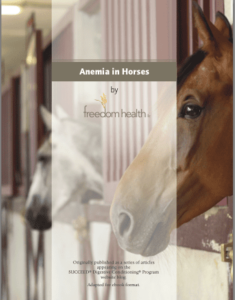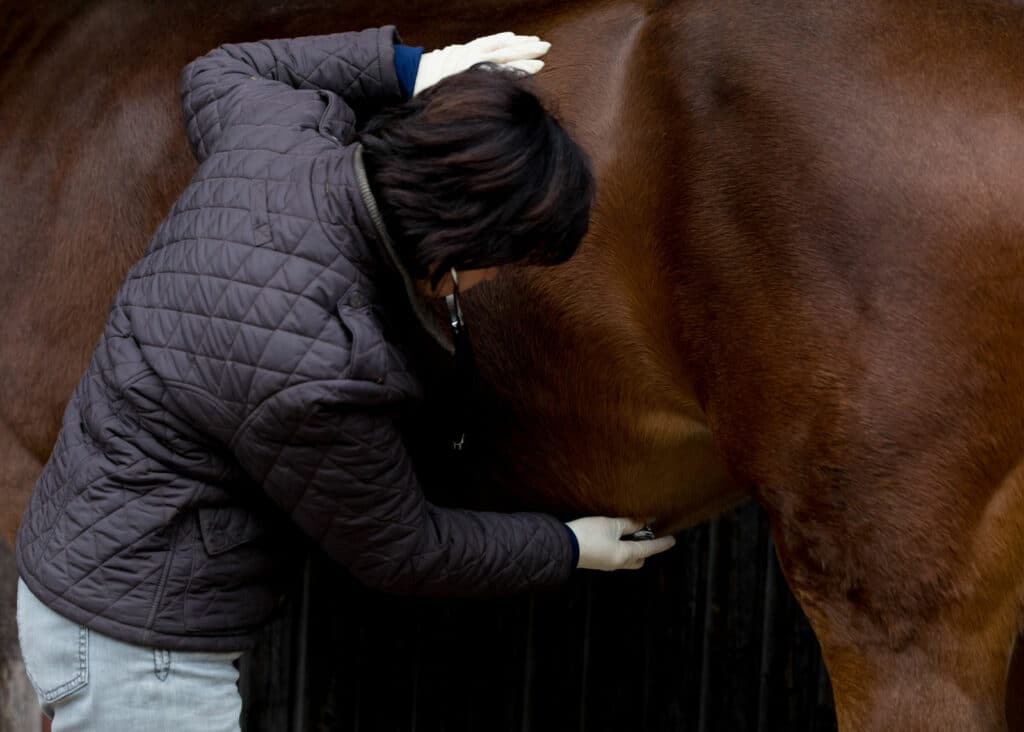Anemia in horses is rarely discussed outside of racing circles, but is an insidious condition with significant impact on a horse’s health and performance ability. In this five part series, we will provide a comprehensive look at equine anemia: what anemia is and how it affects horses, what causes equine anemia, signs and symptoms, ulcers and anemia, and treatments. Subscribe to the SUCCEED blog to follow the complete series.
Anemia in horses simply refers to a reduction in red blood cells. Because one primary function of red blood cells is to deliver oxygen throughout the body, maintaining appropriate levels is critical to a horse’s ability to perform – especially in disciplines that require endurance and stamina. Metabolism – the production of energy needed for performance – is much more efficient when oxygen is available. Racing or reining, endurance or jumping, one surefire way to
improve your horse’s performance is to increase oxygenation.
In addition to the performance impact, it’s also critical to understand that anemia in horses is always a sign that something is going wrong in a horse’s body. Equine anemia is the symptom of an underlying disease that needs to be diagnosed and treated.
Identifying Equine Anemia
Medically speaking, anemia is defined as a reduction below normal in the concentration of hemoglobin in the blood measured by volume of packed red cells per 100 mL of blood. It occurs when the equilibrium is disturbed between blood loss and blood production.
In layman’s terms, anemia is a lack of hemoglobin (or red blood cells) in the blood that results from either losing blood, not making enough blood, or some combination of both.
Red blood cell levels are commonly measured by packed cell volume (PCV), also known as hematocrit, and represented as a percentage. A blood sample is placed in a centrifuge and separated into its three parts: red blood cells, buffy coat, and plasma. A normal PCV for horses can range from 32%-48%. Therefore, a PCV below 30% typically indicates that the horse may be anemic.
The Dangers of Low-Grade Anemia
You may be inclined to think that red blood cell levels need to drop significantly before they cause a problem for your horse.
But the truth is that even low-grade anemia – levels hovering around that 30% range on a PCV – can impact your horse physically and may indicate a health problem. This is especially true for
high performance athletes. The greater your horse’s physical condition and demand, the higher on the range of normal her red blood cell counts will typically be. Therefore, a red blood cell level low on the normal range or just below may indicate a concern for a racehorse, for example, where it wouldn’t for that pasture pet.
Anemia In Horses Always Indicates a Health Problem
Say your veterinarian runs a blood panel on your horse, and the results of the PCV indicate that your horse is anemic. It’s easy to stop there and simply take steps to treat the anemia. But anemia is never an issue unto itself. It’s a symptom of a condition that is causing a horse to lose blood somewhere, to not produce enough blood, or that is destroying blood. And this condition is certainly impacting the horse’s health in additional ways.
It’s critical to work with your veterinarian to find the cause behind the anemia and treat it as well.
How Anemia Impacts Your Horse
When a horse is anemic, it is suffering from a lack of red blood cells whose main responsibility is ferrying oxygen around the body. For
performance horses, this lack of oxygen to the muscles is especially damaging. It reduces both the horse’s energy and recovery ability – both of which make a huge difference in competition.
Anemia makes your horse lethargic and perhaps even causes him to lose appetite and coat condition.
And these affects don’t include any additional impact from the health condition that is causing the anemia in the first place.
Up Next: What Causes Anemia in Horses
The causes of anemia in horses vary widely, ranging from bacterial infections to autoimmune conditions to
ulcers and injuries. Join us for
Part 2 of the Anemia in Horses series as we explore types and causes of equine anemia.
Subscribe to the SUCCEED Blog to follow the rest of the anemia series as well as additional horse health articles.
 Get Your Free Anemia in Horses E-Book
Get Your Free Anemia in Horses E-Book
Did you find this article helpful? Download your free copy of the Anemia in Horses e-book and take the whole series home with you as a printable PDF to read and share at your leisure.
Register Now to Access Your Free Download:
[register_Email Subscribers]
Already a member?
Login in here to access our E-Book Library.

 Get Your Free Anemia in Horses E-Book
Get Your Free Anemia in Horses E-Book

